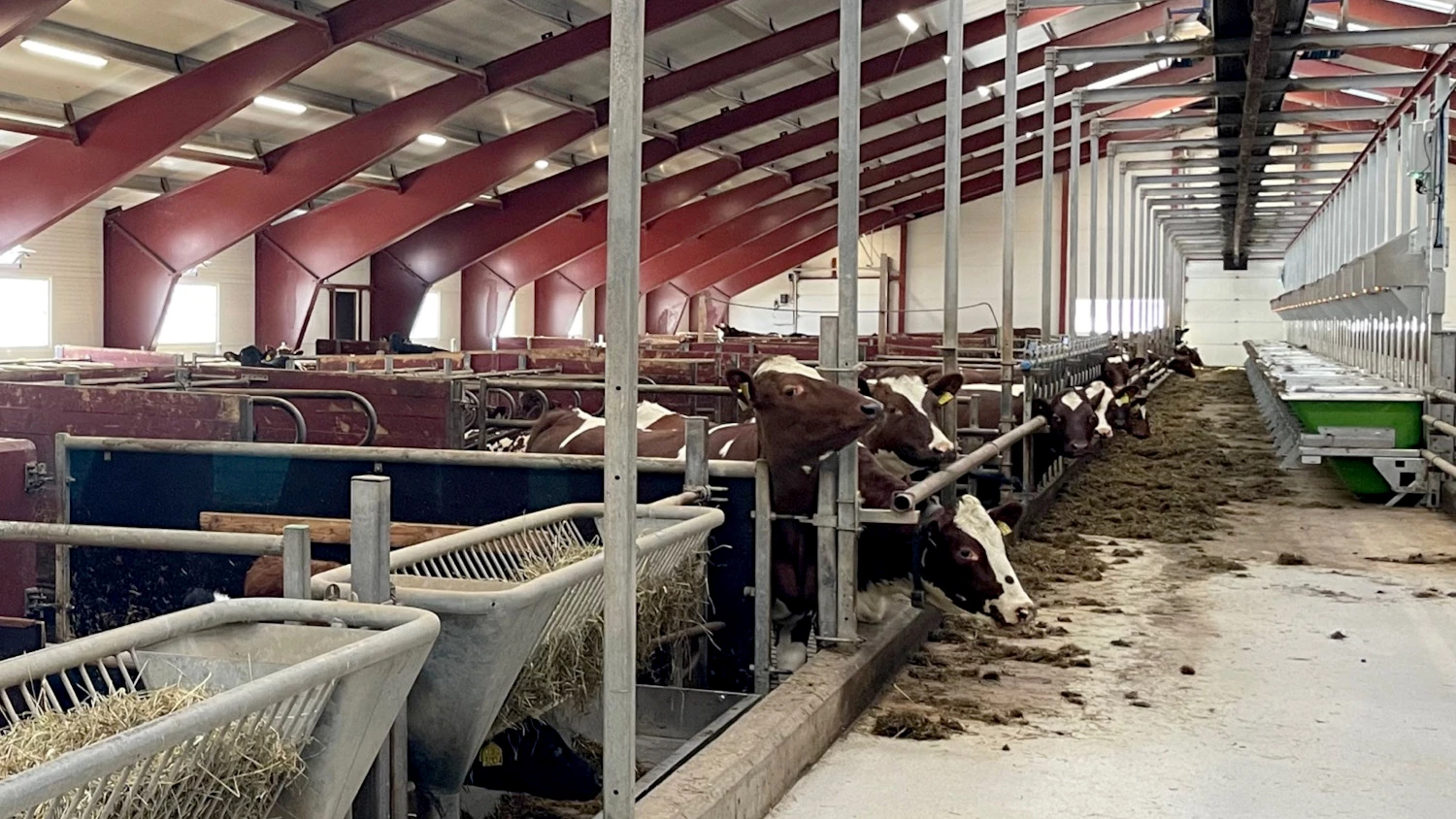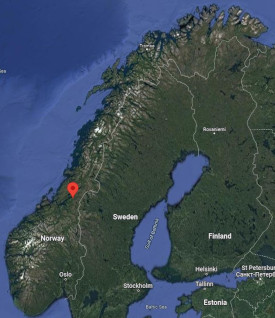This dairy herd is located in Trøndelag county in the middle of Norway, an agricultural region, with flat, fertile land surrounding the wide Trondheim Fjord and Trondheim city.
Trøndelag is also renowned for farms breeding Norwegian Red bulls, with many excellent sires used internationally were born here. 11921 Krovoll and 11919 Ofstad are examples of recent top bulls born in this region. With the unique profile of Trøndelag, we met with a few Norwegian dairy farmers that are very passionate and interested in cattle breeding, to learn more about the Norwegian Red breed and discuss their views on dairying and bovine genetics.
Eklo/Jermstad Samdrift DA
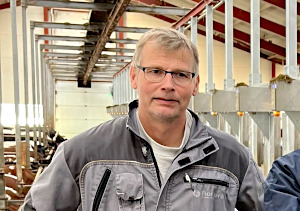
Erlend Hynne, one of the owners. Photo: Trygve R. Solberg
Together with Bjørnar Anderssen, Erlend Hynne is the co-owner of Eklo/Jermstad Samdrift DA in Verdal, Norway. The farm has 100 pure Norwegian Red cows milked by two robots in a nice barn. The barn has adopted both automation for milking and a feeding system and has everything in the right place with cow comfort and welfare visible throughout their herd management.
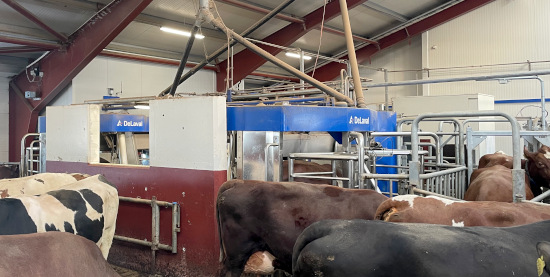 The cows are milked by two milking robots. Photo: Diego Galli
The cows are milked by two milking robots. Photo: Diego Galli
The herd has an annual average milk production of 10.203 Kg/cow with 4,36% fat and 3,53% protein. Fertility is excellent with a calving interval of 11,5 months and cell counts are low with an average of 108.000. For this reason, Erlend is very satisfied with the herd’s performance, and when we had a look at all the herd’s data recorded in the last 10 years, it’s impossible not to agree with him.
“The herd’s performance is a great testament to Norwegian Red, on how big the potential is for the genetics to help improve the profitability of dairy farmers, both in Norway and internationally with crossbreeding,” expressed Diego Galli, Geno’s Regional Sales Manager, EMEA.
When we look at the phenotypic trends of the herd for production, reproduction, and health traits, everything has improved, and quite significantly for some traits. Milk solids Kgs have recorded a 21% increase, calving interval has been stable at 11.5 months (means that cows on average give birth to 1,5 calves per year, excellent performance), somatic cell count stable at about 100.000. Interesting that both milk yield and % have been improving, not easy to achieve and not very common to expect.
When Erlend is asked about what area he needs to improve, his answer was fat, since fat is one of the key requirements of Tine, the Norwegian cooperative that collects most of the milk produced in the country.
For people that are familiar with Norwegian Red genetics, the data about the health of the cows at Eklo/Jermstad won’t be a surprise. For those who still need to learn more about the breed, it’s important to know this is the standard in the Norwegian Red population.
More data from the herd
| Trait | Frequency/year |
| Mastitis | 1,3% |
| Ketosis | 0,3% |
| Milk fever | 0,9% |
| Calving related issues | 0,4% |
It has been proven that metabolic diseases in Norwegian Red practically do not exist, and this is a great strength of the breed. Dairy farmers worldwide understand how such a disease could negatively impact profitability, nevertheless, health will remain a major reason, if not the number one reason, for lower production on farms.
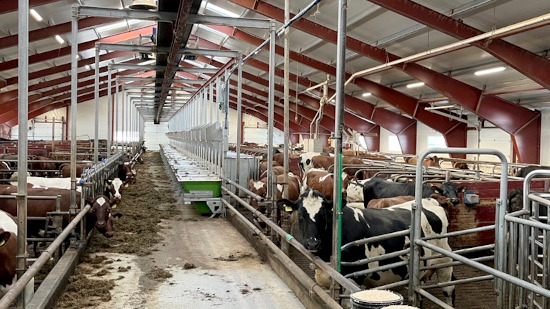 In the barn of Eklo/Jermstad dairy farm. Photo: Diego Galli
In the barn of Eklo/Jermstad dairy farm. Photo: Diego Galli
Adopting technology and innovative breeding strategies
As we enjoy our time discussing farms and cows with Erlend, it is obvious that Erlend is very knowledgeable about dairy farming and is deeply passionate about his work and breeding Norwegian Red. He knows every animal in his barn, from calves to cows, with an excellent overview of all sires and maternal grandsires of his animals. He has a key role in the fantastic results the herd has achieved over the years.
This farm is using all the available technologies to speed up the genetic progress of the herd. All the animals are genotyped, REDX (Norwegian Red sexed semen) is used on top ones while high genetic merit Norwegian Red embryos are used on the bottom part of the herd. Animals are ranked based on Norwegian TMI (Total Merit Index). All the matings are done through the Geno mating plan with the support of TINE breeding advisors Hans Snerting and Jan Atle Bakkenget
“I set my own selection criteria based on which bulls I choose to use and the mating plan to suggest all the matings. We aim to improve fat while considering udder conformation as a very important trait when selecting the bulls” said Erlend.
The herd is also supplying top TMI heifers to Geno for its embryo program and bull calves for Geno’s breeding program.
The new coming bull 12206 NR Raset has been bred here. It’s worth mentioning since he’ll be one the first sons of our popular 12027 Storlfor to be available to international markets. His dam is a 11876 Alm daughter still performing very well in the herd. NR Raset has very high components, both yields, and %, with excellent mastitis resistance and claw health.
Geno’s Feed efficiency and Green cow projects
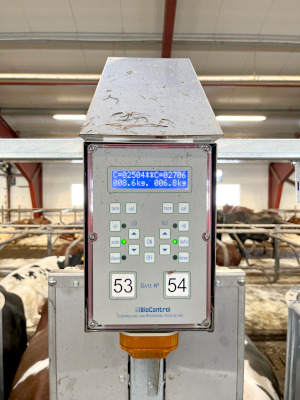
The farm is participating in the Feed Efficiency project run by Geno. Photo: Diego Galli
Eklo/Jermstad dairy farm is participating in both projects. “These are both very important projects and we are in the early stage, especially on monitoring the feed intake. I believe Norwegian and international dairy farmers will further benefit from the results and future development Geno will provide”. Erlend also believes that the farm will soon enjoy the advantages of being able to monitor the real feed intake of the cows and compare it with the daily milk production. By monitoring the data so often, Erlend can see the differences between cows and look closely at how to improve his breeding decisions.
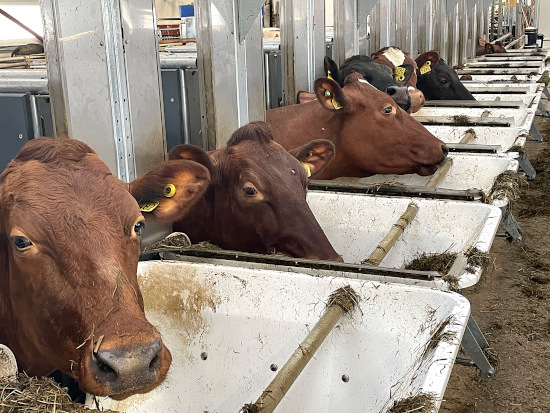
Every cow is monitored on the daily amount of feed they intake. Photo: Diego Galli
The Green Cow project is led by Geno with strong support and collaboration from the Norwegian government, the Norwegian agriculture industry players, and the Norwegian dairy farmers who have been deeply passionate about innovative and sustainable farming since 1935. The project is developed with a bold objective to utilize innovation, advanced technology, and a system that facilitates breeding for a cow with vast milk production traits, superior health, and fertility, efficient feed, and therefore offering lower emissions of methane gas.
